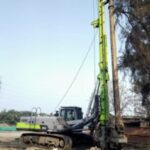Diaphragm wall construction is a technique that involves creating reinforced concrete walls in the ground to support structures such as basements, tunnels and dams. Diaphragm walls are also known as basement diaphragm walls when they are used to form the perimeter of underground spaces. Diaphragm wall construction has undergone significant changes over the years, from the use of conventional equipment such as clamshell grabs and chisels to the adoption of modern equipment such as hydraulic cutters and slurry pumps.
These modern equipment offer several advantages, such as faster and more accurate excavation, better quality and durability of the walls and reduced environmental impact. Here, we will explore the role of modern equipment in d-wall construction and how they have improved the efficiency and safety of this process.
Traditional vs Modern Equipment
One of the main challenges of diaphragm wall construction is to excavate the soil and replace it with concrete without causing any damage to the surrounding structures or the environment. Traditional excavation methods, such as clamshell grabs and chisels, have several limitations, such as low accuracy, high noise and vibration levels and difficulty in handling hard or mixed soils. Moreover, traditional methods require a large working space and a lot of time to complete the excavation and concreting process.
Modern equipment, such as hydraulic cutters and slurry pumps, have revolutionised diaphragm wall construction by overcoming these limitations. Hydraulic cutters can cut through any type of soil with high precision and speed. At the same time, slurry pumps can transport the excavated material and inject the concrete in a continuous and controlled manner. Modern equipment also enables innovative techniques, such as drilling and grouting and top-down construction, which can further enhance the quality and efficiency of diaphragm wall construction.
Modern equipment in action
Let’s look at some of the modern equipment that is used in diaphragm wall construction and how they work.






